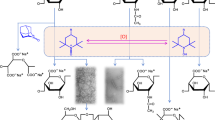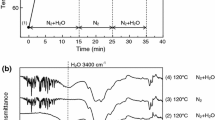Abstract
The mechanism of partial depolymerization of cellouronic acid (β-1,4-linked polyglucuronic acid sodium salt) during 2,2,6,6-tetramethylpiperidine-1-oxyl (TEMPO)-mediated oxidation of cellulose was studied by treating cellouronic acid with one reagent or a combination of TEMPO-NaBr-NaClO under various conditions. Although NaClO, NaBrO and an alkali at pH 11 brought about partial depolymerization of cellouronic acid, the use of these reagents themselves did not seem to be the primary reason for depolymerization. On the other hand, when all the reagents, i.e. TEMPO-NaBr-NaClO, were applied to cellouronic acid at pH 11, a remarkable decrease in weight-average degree of polymerization (DPw) from 430 to ca. 20 was observed within the initial 10 min. Probably hydroxyl radicals formed from NaBrO and TEMPO at pH 10–11 cause the depolymerization during the oxidation. Some radical scavengers were then used for the TEMPO-mediated oxidation of cellulose in order to suppress the depolymerization. Although the addition of crotonic acid under certain conditions gave cellouronic acid having higher DPw, none of the radical scavengers examined so far could completely prevent the depolymerization. When regenerated celluloses having higher DP were used as the starting materials, cellouronic acids having DPw of more than 1000 were obtained, although they still had large low-molecular-weight fractions.
Similar content being viewed by others
References
Bragd P.L., Besemer A.C. and Van Bekkum H. 2000. Bromine-free TEMPO-mediated oxidation of primary alcohol groups in starch and methyl α-D-glucopyranoside. Carbohydr. Res. 328: 355-362.
Bragd P.L., Besemer A.C. and Van Bekkum H. 2001. TEMPO-derivatives as catalysts in the oxidation of primary alcohol groups in carbohydrates. J. Mol. Catal. A: Chemical 170: 35-42.
Bragd P.L., Besemer A.C. and Van Bekkum H. 2002. Selective oxidation of carbohydrates by 4-AcNH-TEMPO/peracid systems. Carbohydr. Polym. 49: 397-406.
De Nooy A.E.J., Besemer A.C. and Van Bekkum H. 1995. Highly selective nitroxyl radical-mediated oxidation of primary alcohol groups in water-soluble glucans. Carbohydr. Res. 269: 89-98.
De Nooy A.E.J., Besemer A.C., Van Bekkum H., Van Dijk J.A.P.P. and Smit J.A.M. 1996. TEMPO-mediated oxidation of pullulan and influence of ionic strength and linear charge density on the dimensions of the obtained polyelectrolyte chains. Macromolecules 29: 6541-6547.
Ibert M., Marsais F., Merbouh N. and Brückner C. 2002. Determination of the side-products formed during the nitroxide-mediated bleach oxidation of glucose to glucaric acid. Carbohydr. Res. 337: 1059-1063.
Isogai A. and Kato Y. 1998. Preparation of polyglucuronic acid from cellulose by TEMPO-mediated oxidation. Cellulose 5: 153-164.
Ishizu A. 1973. Behavior of carbohydrates to oxygen-alkali. J. Japan Tappi 27: 371-377.
Ishizu A. 2000. Alkaline degradation of cellulose. In: Encyclopedia of Cellulose. Asakura Press, Tokyo, pp. 165-176.
Kato Y., Habu, Yamaguchi J., Kobayashi Y.N., Shibata I., Isogai A. et al. 2002. Biodegradation of β-1,4-linked polyglucuronic acid (cellouronic acid). Cellulose 9: 75-81.
Kitaoka T., Isogai A. and Onabe F. 1999. Chemical modification of pulp fibers by TEMPO-mediated oxidation. Nordic Pulp Paper Res J. 14: 274-279.
Matsumoto Y. 2000. Oxidative degradation of cellulose. In: Encyclopedia of Cellulose. Asakura Press, Tokyo, pp. 182-188.
Miyazawa T., Endo T. and Okawara M. 1985. New method for preparation of superoxide ion by use of amino oxide. J. Org. Chem. 50: 5389-5391.
Merbouh N., Thaburet J.F., Ibert M., Marsais F. and Bobbitt J.M. 2001. Facile nitroxide-mediated oxidations of D-glucose to glucaric acid. Carbohydr. Res. 336: 75-78.
Sihtola H., Kyrklund B., Laamanen L. and Palenius I. 1963. Comparison and conversion of viscosity and DP-values determined by different methods. Paperi ja puu 45: 225-232.
Tahiri C. and Vignon M.R. 2000. TEMPO-oxidation of cellulose: synthesis and characterization of polyglucuronans. Cellulose 7: 177-188.
Tobar R.U. 1964. Sulfamic acid in the chlorination and hypochlorite bleaching of pulp. Tappi J. 47: 688-691.
Author information
Authors and Affiliations
Corresponding author
Rights and permissions
About this article
Cite this article
Shibata, I., Isogai, A. Depolymerization of cellouronic acid during TEMPO-mediated oxidation. Cellulose 10, 151–158 (2003). https://doi.org/10.1023/A:1024051514026
Issue Date:
DOI: https://doi.org/10.1023/A:1024051514026




